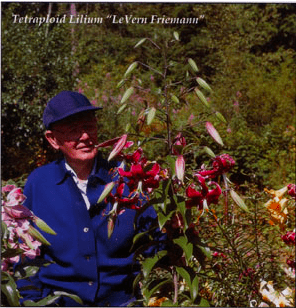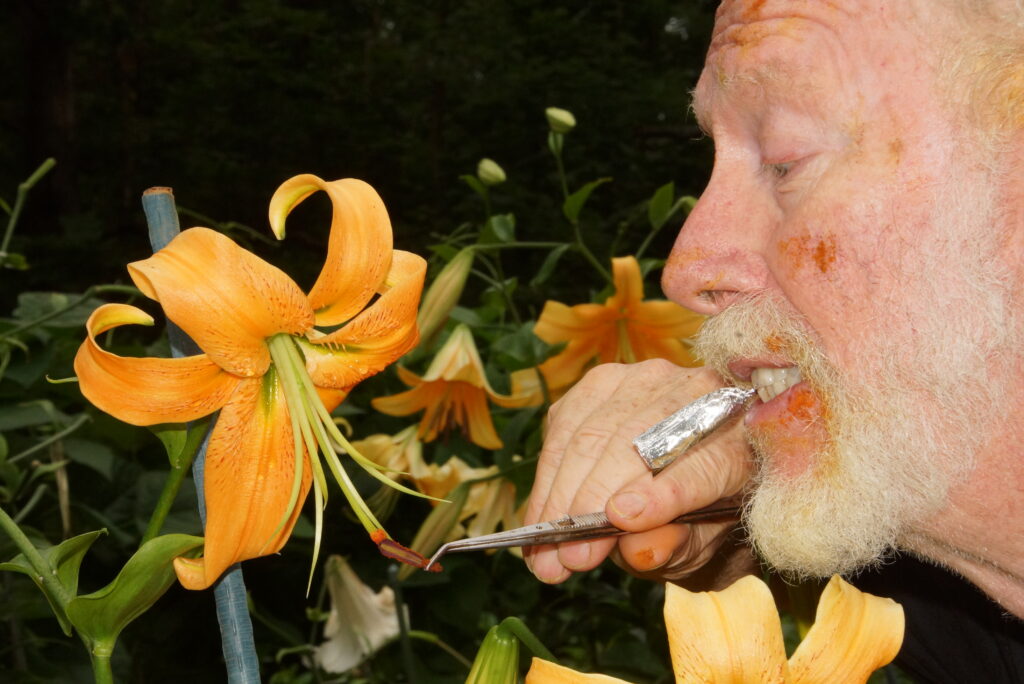by Arthur F. Evans
written 1/1995 revised 12/1995

In our heart of hearts, all hybridizers want to combine the best qualities of all lilies into a series of fabulous beauties with new forms, colors, habits, and seasons. They would be so vigorous, adaptable, and healthy that soon they would be as common as those impostors which only borrow the name lily. Alas, the dream is not yet made flesh, but we are working on it.
Hybrids from different horticultural divisions of the genus Lilium are very hesitant to cross with each other. Species can be even more picky about partners. And yet, with persistence and special techniques sometimes we can coax a miracle out of unlikely and unwilling pairs. One special technique which takes advantage of the occasional halfhearted attempt to produce viable offspring by distantly related lilies is embryo culture or EC. Sometimes a cross will produce one or a few embryos in the seed pod but no normal endosperm, which is the life support system for the embryo. Ordinarily, when this happens the embryo will die as soon as the mature pod starts to dry. The hopeful hybridizer would again be shaking his head over empty seedling flats.
If , however, the embryo is rescued from the green pod and planted on sterile nutrient medium which substitutes for the endosperm, it can grow rapidly and become a valuable hybridizing link between the two parent groups. Until recently EC was thought to be the province of cloistered academics and professional lab technicians, requiring elaborate equipment and exotic potions. No more. In 1987 at the Portland NALS show, Judith McRae taught a large group of amateurs to use the technique utilizing kitchen technology.
If you can muster a large pressure cooker, a sterilizable box with a transparent lid and armholes in the front, and some supplies from Carolina Biological Supply you can soon see results from breakthrough crosses that would be impossible without embryo culture.

The orienpets are hybrids between orientals and trumpets or aurelians. This difficult interdivisional cross has already begun to combine oriental bloom characteristics with the disease resistance and adaptability of aurelians. So far, the orienpets are as a group not very fertile, though many crosses will form embryos without endosperm. This hybrid group is benefiting greatly from the use of EC in the hands of quite a few amateurs as well as pros in North America. Hopefully, each succeeding generation of orienpets will produce a few seedlings a bit more fertile than the last. By selecting for fertility perhaps someday we won’t need EC anymore.
Thunderbolt is an aneuploid, but it breeds as if it were a triploid, that is , it’s slightly pod fertile with tetra aurelian and tetra orienpet pollens. My first successful EC was done one year after I was able to obtain one of Dr. Robert Griesbach’s white tetra aurelians from Borbeleta Gardens. Thunderbolt formed 20 good embryos and a lot more weird ones which didn’t survive. Several clones of (Tb X GW) still exist, all very robust and attractive tetras which form healthy, viable seed when crossed with tetra aurelians. One of the best new orienpets available commercially is ‘Scheherazade’ which Judith McRae selected from her cross (Thunderbolt x tetra Black Beauty), made possible by EC.
Most of my EC now, however, is used on crosses involving seedlings descended from tetra Black Beauty.
had a dream many years ago that Black Beauty could be the foundation of great garden hardy lilies with oriental-type blooms in many colors and forms. He converted Black Beauty to tetraploid status with the mashed pulp of colchicum bulbs because it contains the alkaloid colchicine which interrupts cell division in the first stage of scale bulblet formation. Then he used the tetra pollen on Thunderbolt to create an amazingly vigorous and beautiful series of bred tetras. A commercial lab did the EC on this cross for him. LeVern sent me one of these seedlings in 1989, and I set right to work using pollens from Dr. Griesbach’s tetra aurelians on it and on other orientpets. Most seedlings descended from tetra Black Beauty will form seed pods as big as your fist, which in the latter stages of maturity will give you a very ego-inflating sense of accomplishment. The crash comes when you open the green pods in your sterile transfer case and find few, if any, live embryos. Nonetheless, if you made plenty of pollenations of each cross you can salvage a respectable number of embryos. If all goes well, about half of these will grow on your lily multiplication medium.
I place tubes in bright light at room temperature. You can see the embryos turning from white to green within 7-10 days . Check the tubes at least once a week for contamination. If you see a tiny spot of mold or bacterial growth, immediately transfer the embryo to a fresh tube. I rinse it with chlorhexidine surgical scrub diluted with distilled water. Good luck. Most attempts to salvage embryos from contaminated tubes fail. This year was a lucky one; only about 10% of the tubes became contaminated. Careful attention to sterility inside the EC transfer case is critical. Surgical gloves and keeping instruments and pods wet with 10% bleach solution helps avoid contamination.
Some people take the seedlings out of the tubes as soon as leaves and roots form, planting the seedlings in pots of sterilized soil-less potting mix with a clear plastic ventilated cap until growth resumes. Other people grow the seedlings on through the winter still in the tubes. In early spring they wash the bulblets and pot up as above. Still others wait until a fair-sized bulblet has formed (3mm or more) and remove the bulblets from the tubes. Bulblets are then placed in plastic bags of slightly moist vermiculite and vernalized at 35-40º F for 6-8 weeks before potting. After many failures using other methods, I am now trying the latter two methods.
Hope it works; I’ve got about 300 seedlings from about 25 orienpet crosses growing vigorously in tubes now (Jan ’95). EC is the easy part. Making crosses with the best potential for dependable garden performance and growing the seedlings on to maturity are the hard parts.
Here are some of the crosses which gave good embryos in 1994:
Journey’s End X Schenk’s [tetra Black Beauty X Asano’s 82111 (auratum x henryi)]
New Allegra X Freimann’s 4-way
New Allegra X Woodriff’s Giant Flat Yellow
(tetra Black Beauty X 82111) X Woodriff’s [(tetra Rachel Pappo X tetra Black Beauty ) X Griesbach’s (tetra White Henryi x tetra trumpet)]
Freimann’s (Thunderbolt X tetra Black Beauty) X Woodriff’s [( t.RP X t.BB) X (t.WH X t. t)]
Damson X LeReve and Trance, mixed pollen
Damson X Allegra and L. speciosum var. White Angel, mixed pollen
Damson X Journey’s End and Red Jamboree, mixed pollen
Damson X tetra Unique and Nove Cento, mixed pollen
Asano’s [oriental X (Shikayama X L. henryi)] X Woodriff’s [(t.RP X t. BB) X (t.WH X t. t)]
Journey’s End X Asano’s [oriental X (Shikayama X L. henryi)]
Le Reve X yellow bowl aurelian from Helsley’s (Moon River X Butter Curls)
Leslie Woodriff X Griesbach’s white bowl tetra aurelian
Schenk’s (tetra Journey’s End X tetra Black Beauty) X Schenk’s ( Tetra Black Beauty X 82111)
several clones of my own (tetra Black Beauty X Griesbach’s white tetra aurelians) from embryo culture X tetra aurelians (note: some normal seed from these germinated in pots.)
Some of these are very interesting interdivisional crosses which, if they survive and if they are fertile (two very big ifs), could produce some fascinating bridges to the dream I share with LeVern Freimann. Thanks again to all the hybridizers who made these crosses possible.
_________________________________________________________
Postscript: As of 12/95 there were 97 seedlings from these crosses growing well in pots in the greenhouse. The two methods of treating the infants in their transition to pots seemed to work equally well. The ’95 crop of EC’s, done in October and November, look even better and include some very exciting new combinations, one of which introduces L. longiflorum into my polyploid orienpet group.
©Copyright 1995 by Arthur F. Evans
